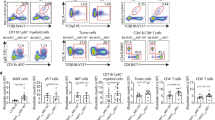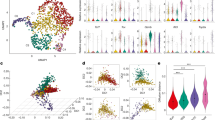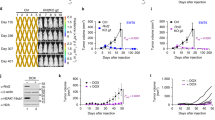Abstract
Upregulation of the inducible gene products MICA (human) and Rae-1 (mouse) may promote tumor surveillance and autoimmunity by engaging the activating receptor NKG2D on natural killer (NK) cells and T cells. Nevertheless, sustained expression of MICA by tumors can also elicit NKG2D downregulation, perhaps indicating 'immunoevasion'. Investigating this paradox, we report here that constitutive Rae-1ε transgene expression in normal epithelium elicited local and systemic NKG2D downregulation, generalized but reversible defects in NK cell–mediated cytotoxicity and mild CD8+ T cell defects. The extent of NKG2D downregulation correlated well with the incidence and progression of cutaneous carcinogenesis, emphasizing the utility of NKG2D as a marker of tumor resistance. Thus, NKG2D engagement is a natural mediator of immunosurveillance, which can be compromised by locally sustained ligand expression but potentially restored by innate immune activation.
This is a preview of subscription content, access via your institution
Access options
Subscribe to this journal
Receive 12 print issues and online access
$209.00 per year
only $17.42 per issue
Buy this article
- Purchase on Springer Link
- Instant access to full article PDF
Prices may be subject to local taxes which are calculated during checkout






Similar content being viewed by others
Accession codes
References
Janeway, C.A., Jr. & Medzhitov, R. Innate immune recognition. Annu. Rev. Immunol. 20, 197–216 (2002).
Girardi, M. et al. Regulation of cutaneous malignancy by γδ T cells. Science 294, 605–609 (2001).
Cerwenka, A. et al. Retinoic acid early inducible genes define a ligand family for the activating NKG2D receptor in mice. Immunity 12, 721–727 (2000).
Diefenbach, A., Jamieson, A.M., Liu, S.D., Shastri, N. & Raulet, D.H. Ligands for the murine NKG2D receptor: expression by tumor cells and activation of NK cells and macrophages. Nat. Immunol. 1, 119–126 (2000).
Bauer, S. et al. Activation of NK cells and T cells by NKG2D, a receptor for stress-inducible MICA. Science 285, 727–729 (1999).
Jamieson, A.M. et al. The role of the NKG2D immunoreceptor in immune cell activation and natural killing. Immunity 17, 19–29 (2002).
Pende, D. et al. Major histocompatibility complex class I-related chain A and UL16-binding protein expression on tumor cell lines of different histotypes: analysis of tumor susceptibility to NKG2D-dependent natural killer cell cytotoxicity. Cancer Res. 62, 6178–6186 (2002).
Groh, V. et al. Broad tumor-associated expression and recognition by tumor-derived γδ T cells of MICA and MICB. Proc. Natl. Acad. Sci. USA 96, 6879–6884 (1999).
Vetter, C.S. et al. Expression of stress-induced MHC class I related chain molecules on human melanoma. J. Invest. Dermatol. 118, 600–605 (2002).
Cerwenka, A., Baron, J.L. & Lanier, L.L. Ectopic expression of retinoic acid early inducible-1 gene (RAE-1) permits natural killer cell-mediated rejection of a MHC class I-bearing tumor in vivo. Proc. Natl. Acad. Sci. USA 98, 11521–11526 (2001).
Diefenbach, A., Jensen, E.R., Jamieson, A.M. & Raulet, D.H. Rae1 and H60 ligands of the NKG2D receptor stimulate tumour immunity. Nature 413, 165–171 (2001).
Tieng, V. et al. Binding of Escherichia coli adhesin AfaE to CD55 triggers cell-surface expression of the MHC class I-related molecule MICA. Proc. Natl. Acad. Sci. USA 99, 2977–2982 (2002).
Groh, V. et al. Costimulation of CD8αβ T cells by NKG2D via engagement by MIC induced on virus-infected cells. Nat. Immunol. 2, 255–260 (2001).
Cosman, D. et al. ULBPs, novel MHC class I-related molecules, bind to CMV glycoprotein UL16 and stimulate NK cytotoxicity through the NKG2D receptor. Immunity 14, 123–133 (2001).
Groh, V., Bruhl, A., El Gabalawy, H., Nelson, J.L. & Spies, T. Stimulation of T cell autoreactivity by anomalous expression of NKG2D and its MIC ligands in rheumatoid arthritis. Proc. Natl. Acad. Sci. USA 100, 9452–9457 (2003).
Ogasawara, K. et al. Impairment of NK cell function by NKG2D modulation in NOD mice. Immunity 18, 41–51 (2003).
Hue, S. et al. A direct role for NKG2D/MICA interaction in villous atrophy during celiac disease. Immunity 21, 367–377 (2004).
Meresse, B. et al. Coordinated induction by IL15 of a TCR-independent NKG2D signaling pathway converts CTL into lymphokine-activated killer cells in celiac disease. Immunity 21, 357–366 (2004).
Ogasawara, K. et al. NKG2D blockade prevents autoimmune diabetes in NOD mice. Immunity 20, 757–767 (2004).
Groh, V., Wu, J., Yee, C. & Spies, T. Tumour-derived soluble MIC ligands impair expression of NKG2D and T-cell activation. Nature 419, 734–738 (2002).
Salih, H.R. et al. Functional expression and release of ligands for the activating immunoreceptor NKG2D in leukemia. Blood 102, 1389–1396 (2003).
Doubrovina, E.S. et al. Evasion from NK cell immunity by MHC class I chain-related molecules expressing colon adenocarcinoma. J. Immunol. 171, 6891–6899 (2003).
Derynck, R., Akhurst, R.J. & Balmain, A. TGF-β signaling in tumor suppression and cancer progression. Nat. Genet. 29, 117–129 (2001).
Castriconi, R. et al. Transforming growth factor β1 inhibits expression of NKp30 and NKG2D receptors: consequences for the NK-mediated killing of dendritic cells. Proc. Natl. Acad. Sci. USA 100, 4120–4125 (2003).
Lee, J.C., Lee, K.M., Kim, D.W. & Heo, D.S. Elevated TGF-β1 secretion and down-modulation of NKG2D underlies impaired NK cytotoxicity in cancer patients. J. Immunol. 172, 7335–7340 (2004).
Carroll, J.M., Albers, K.M., Garlick, J.A., Harrington, R. & Taichman, L.B. Tissue- and stratum-specific expression of the human involucrin promoter in transgenic mice. Proc. Natl. Acad. Sci. USA 90, 10270–10274 (1993).
Kim, S. et al. In vivo developmental stages in murine natural killer cell maturation. Nat. Immunol. 3, 523–528 (2002).
Diebold, S.S. et al. Viral infection switches non-plasmacytoid dendritic cells into high interferon producers. Nature 424, 324–328 (2003).
Alexopoulou, L., Holt, A.C., Medzhitov, R. & Flavell, R.A. Recognition of double-stranded RNA and activation of NF-κB by Toll-like receptor 3. Nature 413, 732–738 (2001).
Johansson, S.E., Hall, H., Bjorklund, J. & Hoglund, P. Broadly impaired NK cell function in non-obese diabetic mice is partially restored by NK cell activation in vivo and by IL-12/IL-18 in vitro. Int. Immunol. 16, 1–11 (2004).
Karre, K. NK cells, MHC class I molecules and the missing self. Scand. J. Immunol. 55, 221–228 (2002).
Koller, B.H., Marrack, P., Kappler, J.W. & Smithies, O. Normal development of mice deficient in β2M, MHC class I proteins, and CD8+ T cells. Science 248, 1227–1230 (1990).
Kelly, A. et al. Assembly and function of the two ABC transporter proteins encoded in the human major histocompatibility complex. Nature 355, 641–644 (1992).
Millrain, M. et al. Examination of HY response: T cell expansion, immunodominance, and cross-priming revealed by HY tetramer analysis. J. Immunol. 167, 3756–3764 (2001).
Girardi, M. et al. Characterizing the protective component of the αβ T cell response to transplantable squamous cell carcinoma. J. Invest. Dermatol. 122, 699–706 (2004).
Salih, H.R., Rammensee, H.G. & Steinle, A. Cutting edge: down-regulation of MICA on human tumors by proteolytic shedding. J. Immunol. 169, 4098–4102 (2002).
Smyth, M.J., Crowe, N.Y. & Godfrey, D.I. NK cells and NKT cells collaborate in host protection from methylcholanthrene-induced fibrosarcoma. Int. Immunol. 13, 459–463 (2001).
Kiessling, R. & Haller, O. Natural killer cells in the mouse: an alternative immune surveillance mechanism? Contemp. Top. Immunobiol. 8, 171–201 (1978).
Martin-Fontecha, A. et al. Induced recruitment of NK cells to lymph nodes provides IFN-γ for T(H)1 priming. Nat. Immunol. 5, 1260–1265 (2004).
Girardi, M. et al. The distinct contributions of murine T cell receptor (TCR)γδ+ and TCRαβ+ T cells to different stages of chemically induced skin cancer. J. Exp. Med. 198, 747–755 (2003).
Gao, Y. et al. γδ T cells provide an early source of interferon γ in tumor immunity. J. Exp. Med. 198, 433–442 (2003).
Zuany-Amorim, C., Hastewell, J. & Walker, C. Toll-like receptors as potential therapeutic targets for multiple diseases. Nat. Rev. Drug Discov. 1, 797–807 (2002).
Shires, J., Theodoridis, E. & Hayday, A.C. Biological insights into TCRγδ+ and TCRαβ+ intraepithelial lymphocytes provided by serial analysis of gene expression (SAGE). Immunity 15, 419–434 (2001).
Carayannopoulos, L.N., Naidenko, O.V., Fremont, D.H. & Yokoyama, W.M. Cutting edge: murine UL16-binding protein-like transcript 1: a newly described transcript encoding a high-affinity ligand for murine NKG2D. J. Immunol. 169, 4079–4083 (2002).
Stephens, H.A. MICA and MICB genes: can the enigma of their polymorphism be resolved? Trends Immunol. 22, 378–385 (2001).
Niwa, H., Yamamura, K. & Miyazaki, J. Efficient selection for high-expression transfectants with a novel eukaryotic vector. Gene 108, 193–199 (1991).
Mallick-Wood, C.A. et al. Conservation of T cell receptor conformation in epidermal γδ cells with disrupted primary V-γ gene usage. Science 279, 1729–1733 (1998).
Findly, R.C., Roberts, S.J. & Hayday, A.C. Dynamic response of murine gut intraepithelial T cells after infection by the coccidian parasite Eimeria. Eur. J. Immunol. 23, 2557–2564 (1993).
Masuda, H. et al. High levels of RAE-1 isoforms on mouse tumor cell lines assessed by anti-”pan” RAE-1 antibody confer tumor susceptibility to NK cells. Biochem. Biophys. Res. Commun. 290, 140–145 (2002).
Coles, R.M., Mueller, S.N., Heath, W.R., Carbone, F.R. & Brooks, A.G. Progression of armed CTL from draining lymph node to spleen shortly after localized infection with herpes simplex virus 1. J. Immunol. 168, 834–838 (2002).
Acknowledgements
We thank C. Brooks (University of Newcastle), J. Dyson and E. Simpson (Medical Research Council Unit, Hammersmith Hospital), and members of the laboratory for advice and assistance; M. Allen for help with immunohistology and inducible transgenics; R. Ahmed (Emory), J. Shires and D. Barber for lymphocytic choriomeningitis virus infection; F. Watt for an involucrin promoter; G. Bates for the chicken β-actin promoter; and A. Steinle for sharing data before publication. This paper is dedicated to the memory of J. Scheckner. Supported by the Wellcome Trust (D.E.O. and A.C.H.) and the National Institutes of Health (R.E.T. and M.G.).
Author information
Authors and Affiliations
Corresponding author
Ethics declarations
Competing interests
The authors declare no competing financial interests.
Supplementary information
Supplementary Fig. 1
Generating Rae-1 transgenic mice. (PDF 2723 kb)
Supplementary Fig. 2
Rae-1 transgene expression in lymphocyte populations (PDF 4487 kb)
Supplementary Fig. 3
Specific loss of NKG2D staining in Rae-1 transgenic mice. (PDF 5029 kb)
Supplementary Fig. 4
Rae-1 is sufficient to drive NKG2D downregulation in vitro. (PDF 6952 kb)
Supplementary Fig. 5
In vivo natural cytotoxicity to Rae-1 targets is dependent on NK cells but not αβ T cells. (PDF 2120 kb)
Supplementary Fig. 6
HY-specific CD8 memory T cell cytotoxicity in Rae-1 transgenic mice. (PDF 1727 kb)
Rights and permissions
About this article
Cite this article
Oppenheim, D., Roberts, S., Clarke, S. et al. Sustained localized expression of ligand for the activating NKG2D receptor impairs natural cytotoxicity in vivo and reduces tumor immunosurveillance. Nat Immunol 6, 928–937 (2005). https://doi.org/10.1038/ni1239
Received:
Accepted:
Published:
Issue Date:
DOI: https://doi.org/10.1038/ni1239
This article is cited by
-
Roles of natural killer cells in immunity to cancer, and applications to immunotherapy
Nature Reviews Immunology (2023)
-
Different effects of NK cells and NK-derived soluble factors on cell lines derived from primary or metastatic pancreatic cancers
Cancer Immunology, Immunotherapy (2023)
-
Dysfunction of natural killer cells in end-stage kidney disease on hemodialysis
Renal Replacement Therapy (2021)
-
Association of MICA-129Met/Val polymorphism with clinical outcome of anti-TNF therapy and MICA serum levels in patients with rheumatoid arthritis
The Pharmacogenomics Journal (2020)
-
Clonal expansion of innate and adaptive lymphocytes
Nature Reviews Immunology (2020)



